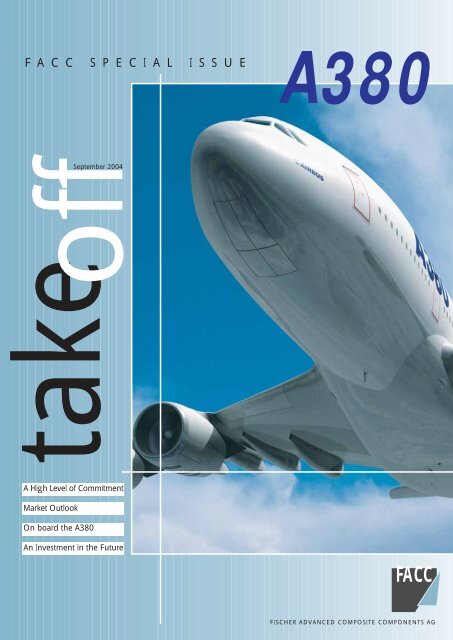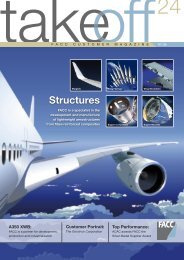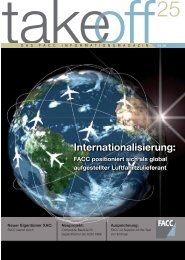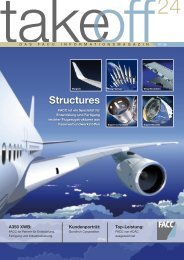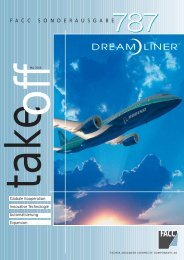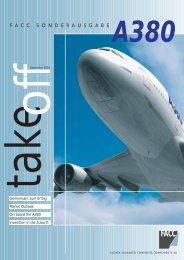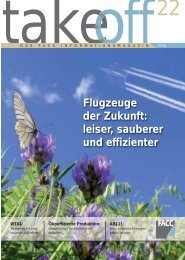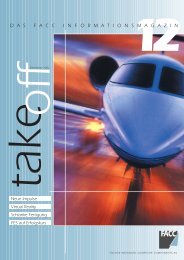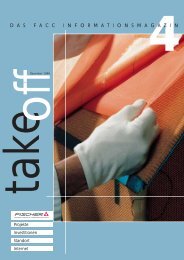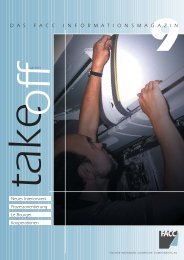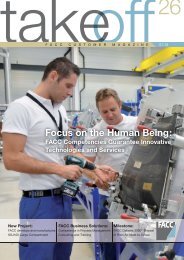Create successful ePaper yourself
Turn your PDF publications into a flip-book with our unique Google optimized e-Paper software.
F A C C S P E C I A L I S S U E<br />
<strong>A380</strong><br />
take off<br />
September 2004<br />
A High Level of Commitment<br />
Market Outlook<br />
On board the <strong>A380</strong><br />
An Investment in the Future<br />
<strong>FACC</strong><br />
FISCHER ADVANCED COMPOSITE COMPONENTS AG
F A C C S P E C I A L I S S U E A 3 8 0<br />
A Strong<br />
Partnership<br />
“The delivery of the first flap track<br />
fairings for the new <strong>Airbus</strong> <strong>A380</strong> in<br />
September 2004 will be seen as a<br />
milestone in the company history of<br />
<strong>FACC</strong>. In the past years we have invested<br />
enormously in the research and development<br />
of components and systems for<br />
the new pioneering super-jumbo. Thus<br />
we were able to develop innovative<br />
complete solutions for <strong>Airbus</strong> with<br />
technological innovations and efficient<br />
product features. We were also given<br />
the opportunity, through our close cooperation<br />
with the <strong>Airbus</strong> development<br />
teams and our partners and suppliers,<br />
to make use of our full innovation<br />
potential and further expand our technological<br />
leadership in the area of<br />
composites.<br />
The successful cooperation between<br />
<strong>Airbus</strong> and <strong>FACC</strong> began in the year<br />
1981. The <strong>A380</strong> is not our only project<br />
which finds us in a risk sharing partnership<br />
with our customer. It follows other<br />
programs from <strong>Airbus</strong>, Boeing and<br />
Bombardier, such as the A340-500/600,<br />
the B717 and the Challenger 300, to<br />
name but a few. But the involvement<br />
of <strong>FACC</strong> in the <strong>A380</strong> program is by far<br />
the most intensive.<br />
The days are gone when <strong>FACC</strong> was a<br />
producer of individual small components.<br />
We have successfully established<br />
ourselves as a system supplier for<br />
the aviation industry and offer our<br />
customers the most sophisticated and<br />
specialized total solutions, be it planning<br />
and development, materials, production<br />
or logistics. That is also the reason why<br />
know-how and high-technology from<br />
<strong>FACC</strong> is on board the <strong>A380</strong> program. I<br />
would like to take this opportunity to<br />
express my thanks to <strong>Airbus</strong> for the<br />
many years of confidence they have<br />
had in us. Thanks to the commitment<br />
and unbelievable work that was put<br />
into this project, especially by our<br />
employees, customers, suppliers and<br />
partners, <strong>FACC</strong> is a recognized 1st tier<br />
supplier in this demanding program<br />
and has been able to fulfil all objectives<br />
and goals. This is without a doubt an<br />
excellent foundation for the years to<br />
come. We are looking forward to new<br />
challenges and are confident that<br />
composite materials and <strong>FACC</strong> AG will<br />
play an important role in the coming<br />
new developments.<br />
In less than six months´ time we will be<br />
proudly looking towards Toulouse<br />
when the first <strong>A380</strong> takes its maiden<br />
flight and a new chapter in the history<br />
of civil aviation will be written.”<br />
Walter Stephan<br />
Chairman of the Board, <strong>FACC</strong> AG<br />
takeoff2
F A C C S P E C I A L I S S U E A 3 8 0<br />
A High Level<br />
of Commitment<br />
“Within a year of <strong>FACC</strong> delivering its first components<br />
to <strong>Airbus</strong> in May 2003, the first <strong>A380</strong> completed<br />
structural assembly.<br />
Just two months later the electrical generation and<br />
distribution systems were powered up for the first time<br />
and assembly is already underway on the eighth<br />
aircraft. So the <strong>A380</strong> is now well into series production,<br />
with the much-anticipated maiden flight planned for<br />
early next year.<br />
This would never have been possible without the<br />
continuing support of suppliers and industrial partners<br />
across the <strong>A380</strong> program. Many of whom, including<br />
<strong>FACC</strong>, demonstrated their confidence in the <strong>A380</strong> by<br />
funding elements of the research and development<br />
related to their areas of expertise, often creating<br />
ground breaking solutions and identifying innovative<br />
applications for new materials and techniques. And this<br />
level of commitment, right through the supply chain,<br />
will be just as critical in ensuring the highest possible<br />
level of maturity when the aircraft enters commercial<br />
service in 2006.<br />
But for the moment, with just a few months to go<br />
before the world gets its first proper look at the <strong>A380</strong>,<br />
I would like to offer our thanks to the teams at <strong>FACC</strong>.<br />
When the first <strong>A380</strong> takes to the sky, I think that the<br />
people at <strong>FACC</strong> will feel every bit as proud as the<br />
people at <strong>Airbus</strong> – and rightly so.”<br />
Charles Champion<br />
Executive Vice President<br />
<strong>A380</strong> Programme, <strong>Airbus</strong><br />
3 takeoff
F A C C S P E C I A L I S S U E A 3 8 0<br />
Market Outlook<br />
<strong>Airbus</strong> predicts that passenger traffic<br />
will increase by more than 5% per year<br />
over the next 20 years, creating<br />
demand for around 1,500 very large<br />
aircraft (including 300 freighters),<br />
which are expected to make some<br />
3,400 flights per day out of 209 airports.<br />
With 70 per cent of flights expected<br />
to be clustered around 25 key<br />
airports, more than half of all very large<br />
aircraft likely to be used on flights from<br />
just ten airports, eight of which will be<br />
in Asia Pacific.<br />
However, given the need to balance<br />
the growing demand for air travel, with<br />
limited landing slots at airports, growing<br />
competition and an increasingly<br />
sensitive environment, these aircraft<br />
are likely to be used on a complete<br />
range of domestic, local, regional and<br />
intercontinental routes: one third are<br />
expected to operate on routes of less<br />
than 2,000 km (such as Hong-Kong to<br />
Beijing) while another third will be<br />
used on routes of over 9,000km (such<br />
as Paris to Los Angeles).<br />
After working closely with airlines,<br />
industrial partners and suppliers, and a<br />
whole host of experts from across the<br />
industry, <strong>Airbus</strong>’ answer was the <strong>A380</strong>:<br />
combining a wealth of innovative new<br />
technology with all that is best about<br />
the existing <strong>Airbus</strong> Family.<br />
Entering service in 2006, the <strong>A380</strong> will<br />
generate up to 15 per cent lower seat<br />
per mile costs, 13 per cent less fuel<br />
consumption and half the noise of its<br />
closest competitor, while carrying 35<br />
per cent more passengers and meeting<br />
strict local regulations, such as QC2 for<br />
departure at London airports. Two<br />
years later, the <strong>A380</strong>F will offer 30 per<br />
cent more payload, 54 per cent more<br />
volume and 2,600km/1,400nm more<br />
range than competing aircraft.<br />
In the future, further variants of the<br />
<strong>A380</strong> will be developed in response to<br />
market demand when and if it evolves.<br />
With 139 orders and commitments<br />
from 13 customers before it has made<br />
its first flight, <strong>Airbus</strong> remains confident<br />
that the <strong>A380</strong> is the solution that<br />
the industry, passengers and the<br />
environment need.<br />
takeoff4
F A C C S P E C I A L I S S U E A 3 8 0<br />
On board<br />
the <strong>A380</strong><br />
The <strong>Airbus</strong> <strong>A380</strong> is the most important civil aircraft program to date – one which<br />
sets new standards in many respects and will add a new dimension to civil aviation.<br />
The future super-jumbo is of great significance for <strong>FACC</strong> as a recognized partner in<br />
development for the different EADS affiliates.<br />
Since the mid-1990s, <strong>Airbus</strong> was<br />
working on the vision of an airplane that<br />
could carry over 500 passengers. The<br />
new aircraft of the 21st century that<br />
could transport a large number of<br />
passengers over long distances was<br />
thought to be an environmentally<br />
friendly solution to the increase in air<br />
traffic. With the launch of the program<br />
in December 2000, the go-ahead was<br />
given to build the largest airplane ever.<br />
As far as the development of the new<br />
passenger plane was concerned,<br />
<strong>Airbus</strong> followed new paths from the<br />
very beginning in the selection of and<br />
cooperation with suppliers and partners.<br />
In a global selection process a<br />
kind of dream team was formed and<br />
given the job of jointly designing the<br />
roomiest, most modern and most<br />
efficient airplane that had ever been<br />
built. The <strong>A380</strong> is a product of worldwide<br />
cooperation and partnership and<br />
the result of years of joint efforts of<br />
thousands of employees of <strong>Airbus</strong> and<br />
its partner companies. And a player on<br />
this team was <strong>FACC</strong>, a company that<br />
could use its expertise in composite<br />
technology to make a small but<br />
forward-looking contribution, allowing<br />
the vision of the <strong>A380</strong> to become a<br />
reality.<br />
<strong>A380</strong> and <strong>FACC</strong><br />
The <strong>A380</strong> passenger plane is of great<br />
significance for <strong>FACC</strong>, Austria’s leading<br />
aviation supplier. The high-tech company<br />
has successfully established itself<br />
as a development partner of EADS and<br />
has been a part of the <strong>A380</strong> program<br />
since its conceptual phase. <strong>FACC</strong><br />
is responsible for the design and<br />
production of important components<br />
and systems for the fuselage, wings,<br />
and engines as well as different<br />
components of the passenger cabin of<br />
the flagship <strong>A380</strong>. For the development<br />
department of <strong>FACC</strong> the <strong>A380</strong> is<br />
the most comprehensive development<br />
program to date, whether the timing<br />
and extent of the participation in the<br />
program is concerned, of the size<br />
and complexity of the systems and<br />
components or the new dimensions in<br />
the area of production.<br />
In close cooperation with the <strong>Airbus</strong><br />
teams in Germany and France and with<br />
Rolls-Royce and the Engine Alliance,<br />
the main suppliers for both engines,<br />
<strong>FACC</strong> set up a competence network<br />
which includes numerous Austrian and<br />
international suppliers as well as<br />
partners at universities and research<br />
centers.<br />
5 takeoff
F A C C S P E C I A L I S S U E A 3 8 0<br />
A Milestone:<br />
First Delivery of Flap<br />
Track Fairings for<br />
the <strong>A380</strong><br />
In September 2004 <strong>FACC</strong> delivered the first flap<br />
track fairings for the <strong>Airbus</strong> <strong>A380</strong> – a milestone<br />
in the company history of <strong>FACC</strong> and an example<br />
of a successful development project that<br />
emphasizes the leading technological position of<br />
the company. For <strong>FACC</strong> the flap track fairing is<br />
not only the most important structure project for<br />
the <strong>A380</strong>, but also the most extensive and<br />
largest sub-system that is being produced by<br />
<strong>FACC</strong>. This aerodynamic fairing contains a<br />
number of technical systems essential for flight,<br />
and <strong>FACC</strong>´s development team is responsible for<br />
their integration. These systems include a<br />
cooling system for the hydraulic units, an<br />
emergency power turbine and a fuel drain line.<br />
Per wing <strong>FACC</strong> produces five flap track fairings<br />
of different dimensions. The largest fairing is<br />
11 meters long, 0.80 meters wide, 1.40 meters<br />
in height and, thanks to the use of advanced<br />
carbon fiber composites, weighs only 1,200 kilos.<br />
takeoff6
F A C C S P E C I A L I S S U E A 3 8 0<br />
7<br />
takeoff
F A C C S P E C I A L I S S U E A 3 8 0<br />
An Investment<br />
in the Future<br />
The <strong>Airbus</strong> <strong>A380</strong> program poses a<br />
great challenge for <strong>FACC</strong>, and at the<br />
same time contributes to a lasting<br />
positive development of the company.<br />
Once series production is in full swing<br />
in 2005, hundreds of individual components<br />
will be delivered from Ried.<br />
Starting in 2005 an average of 200<br />
employees will be needed for the following<br />
20 years for the program that will<br />
be bringing in significant annual<br />
increase of <strong>FACC</strong>´s turnover.<br />
From the very beginning of the design<br />
to the development of details and up<br />
to production, a strong partnership was<br />
forged with <strong>Airbus</strong> that creates an ideal<br />
basis for a future long-term relationship.<br />
The acquired know-how and techno-<br />
takeoff<br />
8
F A C C S P E C I A L I S S U E A 3 8 0<br />
logical innovations are expanding<br />
<strong>FACC</strong>´s technological leadership as a<br />
systems supplier and the goal is to<br />
provide the best products and services<br />
for the <strong>Airbus</strong> <strong>A380</strong> program and other<br />
customers´ programs.<br />
9 takeoff
F A C C S P E C I A L I S S U E A 3 8 0<br />
<strong>FACC</strong> and it’s contribution to the <strong>A380</strong><br />
On the <strong>A380</strong> program <strong>FACC</strong> AG is involved in 10 detail projects for a total of 9 different customers from<br />
5 different customer consortia, with orders from Germany, England, France, Japan, Canada, and the USA.<br />
In the years to come these orders will make up a delivery volume of $1 billion and in the long run<br />
constitute about 15% of the total turnover of <strong>FACC</strong>.<br />
Component<br />
Overhead Stowage Compartments<br />
Flap Track Fairings<br />
Flap Rips<br />
Composite components for Trent 900<br />
APU Inlet Plenum<br />
Engine components for GP7200<br />
Cargo Compartment Door Lining<br />
Cross Beam Floor Struts<br />
Inner Outer Barrel<br />
Bathtube Panels<br />
Customer<br />
Aircabin GmbH., Germany<br />
<strong>Airbus</strong> Germany<br />
<strong>Airbus</strong> Germeny<br />
Rolls-Royce, UK<br />
Pratt & Whitney, Canada<br />
Pratt & Whitney, USA<br />
Mitsubishi Heavy Industries, Japan<br />
JAMCO, Japan<br />
<strong>Airbus</strong> France<br />
EADS Military, Germany<br />
takeoff10
F A C C S P E C I A L I S S U E A 3 8 0<br />
Make your own <strong>A380</strong><br />
Some tips for a better flight<br />
1. Cut out the plane´s fuselage and<br />
tail<br />
carefully following the outer<br />
black lines. Also cut out the sits<br />
that are located on the rear<br />
and on the sides of the fuselage<br />
(they appear as thick black lines).<br />
2.Fold the plane´s fuselage<br />
all along the central dotted line.<br />
● You may get better results by adjusting slightly the wings and the<br />
tail.<br />
● Hold the plane behind the wings and throw it horizontally.<br />
● The plane will fly further if you place a paper clip on its nose.<br />
FOLD<br />
3. First fold down the tail along the central dott ed<br />
line then fold it up along the dotted lines of the<br />
sides.<br />
4.While flattening it with your thumb and forefinger,<br />
insert the plane’s tail gently at a 45° angle<br />
in the corresponding slits that you previously cut<br />
out in the fuselage.<br />
Then pull it firmly upwards and backwards.<br />
45° angle<br />
CUT THE SLITS FOR THE TAIL<br />
A<br />
FOLD<br />
B<br />
FOLD<br />
FOLD<br />
C<br />
CUT<br />
THE SLIT<br />
5. Fold up the A BB and C C parts on themselves.<br />
Make sure they are in between the forward fuselage<br />
sides so that the printed areas still show.<br />
Insert part D in the corresponding slit.<br />
The plane’s fuselage is now flat.<br />
FOLD<br />
Careful<br />
Do not throw<br />
the plane in direction<br />
of people, animals or fragile objects.<br />
D<br />
FOLD<br />
6. Straighten the wings and the tail’s horizontal<br />
sides. Fold the engines down vertically and fold<br />
the tips of the wings upwards.<br />
11 takeoff
Make your <strong>FACC</strong> <strong>A380</strong><br />
Some tips for a better flight<br />
1. Cut out the plane´s fuselage and<br />
tail<br />
carefully following the outer<br />
black lines. Also cut out the sits<br />
that are located on the rear<br />
and on the sides of the fuselage<br />
(they appear as thick black lines).<br />
2.Fold the plane´s fuselage<br />
all along the central dotted line.<br />
● You may get better results by adjusting slightly the wings and the<br />
tail.<br />
● Hold the plane behind the wings and throw it horizontally.<br />
● The plane will fly further if you place a paper clip on its nose.<br />
FOLD<br />
3. First fold down the tail along the central dott ed<br />
line then fold it up along the dotted lines of the<br />
sides.<br />
4. While flattening it with your thumb and forefinger,<br />
insert the plane’s tail gently at a 45° angle<br />
in the corresponding slits that you previously cut<br />
out in the fuselage.<br />
Then pull it firmly upwards and backwards.<br />
45° angle<br />
CUT THE SLITS FOR THE TAIL<br />
A<br />
FOLD<br />
B<br />
FOLD<br />
FOLD<br />
C<br />
CUT<br />
THE SLIT<br />
5. Fold up the A BB and C C parts on themselves.<br />
Make sure they are in between the forward fuselage<br />
sides so that the printed areas still show.<br />
Insert part D in the corresponding slit.<br />
The plane’s fuselage is now flat.<br />
FOLD<br />
Careful<br />
Do not throw<br />
the plane in direction<br />
of people, animals or fragile objects.<br />
D<br />
FOLD<br />
6. Straighten the wings and the tail’s horizontal<br />
sides. Fold the engines down vertically and fold<br />
the tips of the wings upwards.<br />
<strong>FACC</strong><br />
FISCHER ADVANCED COMPOSITE COMPONENTS AG<br />
A-4910 Ried/Austria, Fischerstraße 9, P.O.Box 192<br />
Tel. +43/7752/616-0, Fax +43/7752/616-352<br />
www.facc.co.at, e-mail: info@facc.co.at<br />
Photos: Lang & Lang Leonding, <strong>Airbus</strong> Toulouse, Design and Composition: Oskar Pointecker, 4941 Mehrnbach.


